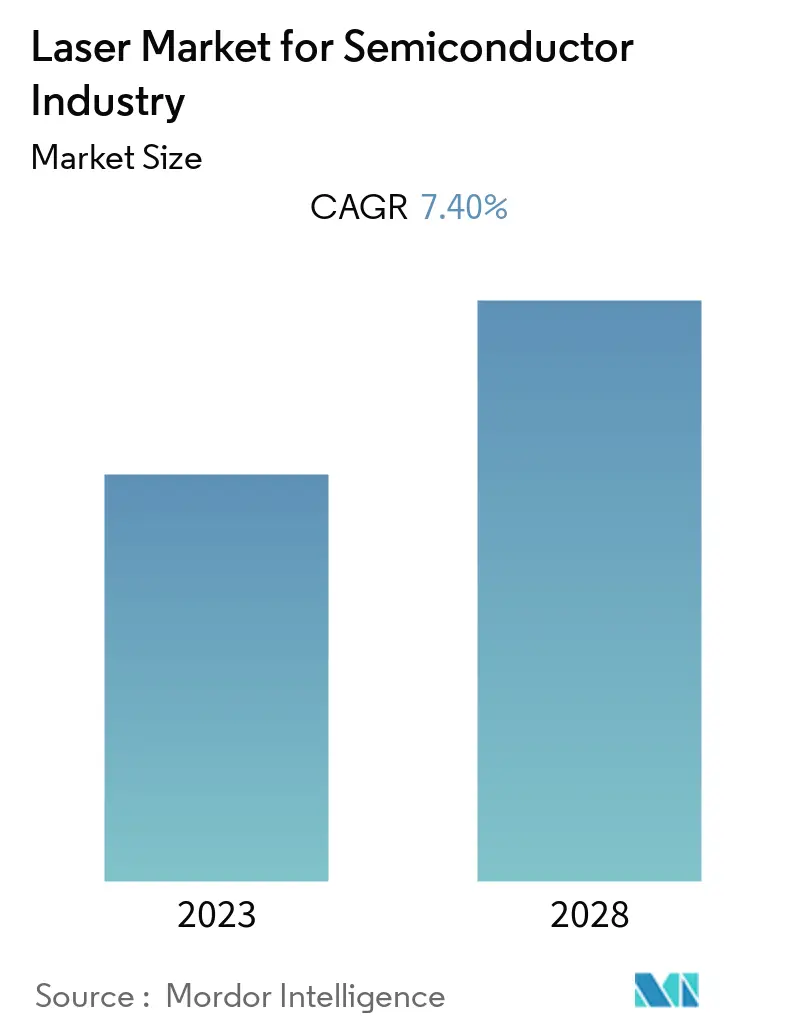Market Size of Laser Industry for Semiconductor Industry

| Study Period | 2017-2027 |
| Base Year For Estimation | 2021 |
| CAGR | 7.40 % |
| Fastest Growing Market | Asia-Pacific |
| Largest Market | North America |
| Market Concentration | Medium |
Major Players*Disclaimer: Major Players sorted in no particular order |
Need a report that reflects how COVID-19 has impacted this market and its growth?
Semiconductor Industry Laser Market Analysis
The Laser Market for Semiconductor Industry is anticipated to register a CAGR of 7.4% during the forecast period. Lasers are gaining significant traction in the semiconductor industry as they offer flexible, advanced machining to meet stringent requirements of the industry, providing semiconductor manufacturers with a highly accurate method of cutting complex shapes from various materials. Lasers allow materials to be sliced into infinite shapes and patterns with high precision. A laser system custom designed for semiconductor application can cut a wide range of materials accurately and quickly.
- The semiconductor market is witnessing several innovations owing to robust R&D activities. For instance, in November 2022, researchers from the LP3 Laboratory in France developed a direct laser writing technique to achieve local material processing within the 3D space of semiconductor chips. They claim that the dominating manufacturing technology, lithography, has substantial limitations in thoroughly addressing the challenges posed by the semiconductor manufacturing sector. For this reason, they suppose that fabricating structures under the wafer surfaces would be highly desirable to exploit the full space inside the materials. In the International Journal of Extreme Manufacturing, the researchers demonstrated such capability vis the newly developed direct laser writing technique, which facilitates fabricating embedded structures inside various semiconductor materials. Further, in June 2022, engineers at the University of California, Berkeley (Department of Electrical Engineering and Computer Sciences (EECS)) created a new type of semiconductor laser that accomplishes an elusive goal in the field of optics: the ability to maintain a single mode of emitted light while maintaining the ability to scale up in size and power. It is claimed to be a significant achievement as it means size does not have to come at the expense of coherence, enabling lasers to be more powerful and to cover longer distances for many applications.
- The studied market is witnessing an upsurge in demand owing to numerous initiatives by governments of various nations. For instance, the United States government aims to become independent in the semiconductor supply chain ecosystem. In these efforts, in December 2021, senators in the United States introduced Investing in Domestic Semiconductor Manufacturing Act in the senate. This proposed legislation would expand eligibility for CHIPS for America, a government subsidy program for the semiconductor industry, to fund financial assistance beyond entities involved in semiconductor fabrication, testing, assembly, or R&D to organizations involved with materials used to manufacture semiconductors and semiconductor manufacturing equipment. By incentivizing the companies that produce essential materials and equipment, this legislation can create more opportunities for manufacturers across the country and strengthen the supply chain that supports domestic semiconductor manufacturing
- Additionally, in September 2022, the Biden administration announced that it would invest USD 50 billion in building up the domestic semiconductor industry to counter dependency on China, as the US produces zero and consumes 25% of the world's leading-edge chips vital for its national security. President Joe Biden signed a USD 280 billion CHIPS bill in August 2022 to boost domestic high-tech manufacturing, part of his administration's push to increase US competitiveness over China. Such robust investments in the semiconductor sector in the region would offer lucrative opportunities for the growth of the studied market.
- The outbreak of COVID-19 globally has significantly disrupted the supply chain and production of the studied market in the initial phase of 2020. For circuit and chipmakers, the impact was more severe. Due to labor shortages, many packages and testing plants in the Asia-Pacific region reduced or even suspended operations. This also created a bottleneck for end-product companies that depend on semiconductors. However, many of these effects are likely to be short-term. Precautions by governments across the globe to support automotive and semiconductor sectors could help revive industry growth.
- On the Flipside, the initial calibration of lasers is a very complex task and requires a high level of expertise to achieve the high-precision tuning required for the application. Also, the huge number of parameters has to be considered while tuning the laser, and a small offset may lead to errors or be catastrophic in various applications. The manufacturing process of the lasers is very complex, due to which the manufacturing cost has also increased significantly. Another important aspect of the laser's performance when switching between wavelengths is the wavelength stability of the device. As the laser tunes into its desired wavelength, there is a settling drift before the channel finally stabilizes. Such factors might hinder the growth of the studied market.
